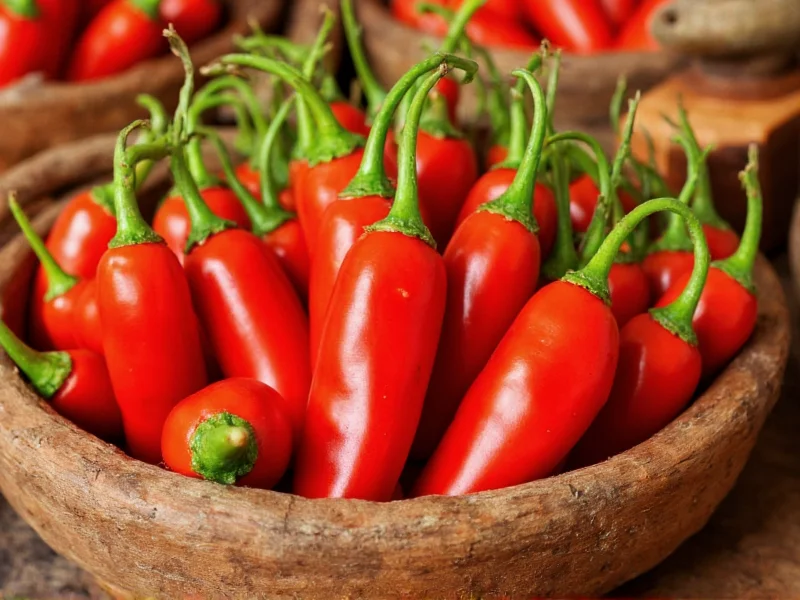Understanding where jalapeños fall on the spicy scale helps home cooks and food enthusiasts make informed decisions in the kitchen. The Scoville scale, developed by pharmacist Wilbur Scoville in 1912, remains the standard measurement for chili pepper heat intensity. Originally determined through human taste testing, modern laboratories now use high-performance liquid chromatography for precise capsaicin measurement—the compound responsible for that characteristic burn.
Decoding the Jalapeño Heat Range
While jalapeños consistently appear in the 2,500–8,000 SHU range, several factors create significant variation within this bracket. The average jalapeño you'd find in a grocery store typically registers around 5,000 SHU—about eight times milder than a habanero but noticeably hotter than poblano peppers.
What causes this variation? Jalapeño heat depends on multiple factors including:
- Stress during growth: Peppers develop more capsaicin when experiencing environmental stress like drought or temperature fluctuations
- Ripeness: Red jalapeños (fully ripe) often measure hotter than green ones
- Seed and membrane concentration: The white pith and seeds contain most capsaicin
- Cultivar differences: Some jalapeño varieties like 'Mucho Nacho' are bred for consistent heat
- Geographical origin: Soil composition and climate affect final heat levels
| Pepper Variety | Scoville Heat Units (SHU) | Heat Level Comparison |
|---|---|---|
| Jalapeño | 2,500–8,000 | Mild to medium |
| Serrano | 10,000–23,000 | 2-3 times hotter than jalapeño |
| Habanero | 100,000–350,000 | 15-40 times hotter than jalapeño |
| Bell Pepper | 0 | No heat |
| Ghost Pepper | 855,000–1,041,427 | 100-400 times hotter than jalapeño |
Practical Implications for Cooking
Knowing the jalapeno spicy scale helps you control heat in recipes. For milder results, remove seeds and white membranes before chopping. If you need consistent heat for canning or sauces, consider using jalapeño powder with standardized Scoville ratings.
Chefs often employ these techniques to manage jalapeño heat:
- Soak sliced jalapeños in ice water for 15-20 minutes to reduce surface capsaicin
- Cook jalapeños to mellow their heat (capsaicin breaks down with prolonged heat)
- Balance heat with dairy products like sour cream or cheese
- Use acidic components like lime juice to counteract perceived spiciness
Common Misconceptions About Jalapeño Heat
Several myths persist about measuring jalapeño spiciness. Contrary to popular belief, the number of 'corking' lines (streaks on the pepper skin) doesn't reliably indicate heat level—though it does suggest the pepper experienced growth stress. Additionally, smaller jalapeños aren't consistently hotter than larger ones; size correlates more with variety than heat intensity.
Another important consideration: the human perception of jalapeño heat varies significantly. Factors like individual tolerance, previous exposure to capsaicin, and even genetic differences affect how the same jalapeño registers on your personal spicy scale.
Safety Tips for Handling Hot Peppers
When working with jalapeños or hotter varieties, protect your skin and eyes. Capsaicin doesn't dissolve in water but does in fats and oils, so wear gloves during preparation. If you experience burning, reach for milk or yogurt rather than water. Never touch your face while handling hot peppers, and thoroughly wash all surfaces and utensils after use.
Measuring Heat Beyond the Scoville Scale
While the jalapeno spicy scale provides useful reference points, modern food science has developed more precise measurement methods. High-performance liquid chromatography (HPLC) now quantifies exact capsaicinoid concentrations, converting these measurements to Scoville units for consistency with historical data. This scientific approach eliminates the subjectivity of the original taste-based Scoville Organoleptic Test.
FAQ
Why do some jalapeños taste much hotter than others?
Jalapeño heat varies due to growing conditions, with stressed plants producing more capsaicin. Factors like water availability, soil nutrients, temperature fluctuations, and sunlight exposure all influence final heat levels. Even within the same plant, individual peppers can show significant variation in the jalapeno spicy scale.
How does jalapeño heat compare to other common peppers?
Jalapeños (2,500-8,000 SHU) are significantly milder than habaneros (100,000-350,000 SHU) but noticeably hotter than poblanos (1,000-2,000 SHU). They're about 2-3 times milder than serranos and approximately 8 times milder than a typical habanero. On the jalapeno spicy scale, they sit comfortably in the medium-heat category suitable for most palates.
Does the color of a jalapeño affect its heat level?
Yes, color indicates ripeness which affects heat. Green jalapeños are harvested early and tend to be milder, while red jalapeños (fully ripe) often measure hotter on the Scoville scale. However, red jalapeños also develop more sweetness alongside increased heat, creating a more complex flavor profile despite potentially higher jalapeno heat level measurements.
Can I reduce the heat of jalapeños before cooking?
Absolutely. Removing seeds and white membranes eliminates up to 80% of the capsaicin. Soaking sliced jalapeños in ice water for 15-20 minutes reduces surface capsaicin, while cooking mellows heat over time. For consistent results in recipes, consider using measured amounts of jalapeño powder with known Scoville ratings rather than fresh peppers when precise heat control matters.











 浙公网安备
33010002000092号
浙公网安备
33010002000092号 浙B2-20120091-4
浙B2-20120091-4